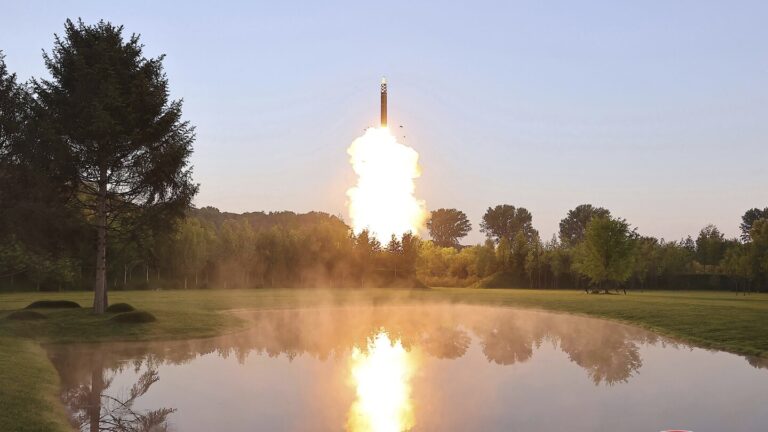SEOUL, South Korea (AP) — North Korea said Thursday it had successfully tested a multiple-warhead missile in the first test of a weapon under development that leader Kim Jong Un covets to overwhelm U.S. and South Korean missile defenses. South Korea quickly dismissed the claim as a whitewash to cover up a failed launch.
North Korea’s state media said Wednesday’s launch was a test of the separation and guidance control of individual mobile warheads to confirm the capabilities of multiple independent reentry vehicles (IRVs). It said the separated warheads were “precisely guided to three coordinate targets,” and that a decoy that separated from the missile was spotted on radar.
If confirmed, it would be North Korea’s first public launch linked to its multiple warhead missile development, although it is still in its early stages.
South Korea’s military said late on Thursday that a joint analysis by South Korean and U.S. authorities had assessed the North’s missile launch to have failed.
Joint Chiefs of Staff spokesman Lee Song-jun told reporters that in multiple-warhead missile tests, the separation of the warheads occurs in stages, but North Korea’s missile exploded early in its flight. He said photos taken by North Korea of the launch showed a weapon similar to the liquid-fueled Hwasong-17 intercontinental ballistic missile that the country test-fired in March 2023.
South Korean military Previous evaluation North Korea said a hypersonic missile believed to be loaded with solid fuel exploded during launch off the country’s east coast on Wednesday, sending debris into the sea. North Korea said it had detected more smoke than usual during launches, suggesting a possible combustion problem caused by an engine malfunction.
Spy satellites, solid-fuel intercontinental ballistic missiles, hypersonic weapons and submarine-launched nuclear missiles were among the high-tech weapons systems that Kim Jong Un listed on his wish list at a ruling party meeting in early 2021. North Korea has since conducted a series of tests aimed at developing these weapons systems.
“I’ve been expecting a MIRV test for some time, as it was one of the last items on Kim Jong Un’s modernization wish list at the Eighth Party Congress in January 2021,” said Ankit Panda, a senior analyst at the Carnegie Endowment for International Peace.
Panda said Wednesday’s test appeared to be an initial evaluation of some key subsystems for developing a working MIRV. He expects that serial tests of the technology could lead to the launch of an intercontinental ballistic missile on a lofted trajectory. “It appears South Korea initially misunderstood the nature of this test,” Panda said.
Lee Choong-geun, an honorary research fellow at the Korea Science and Technology Policy Institute, said North Korea appears to have begun testing individual technological components of its multiple warhead missiles. He said further tests are expected to be conducted to perfect aspects of the multiple warhead missile technology, such as separation, guidance and control.
Chang Yong-geun, a missile expert at the Korea Institute for National Strategy in Seoul, said North Korea’s test has not yet proven it has sufficient MIRV control technology needed for an ICBM. He said North Korea has not released enough information to verify that the MIRVs successfully re-entered the atmosphere and hit their designated targets.
Panda said the presence of a decoy weapon in North Korea’s test was significant, but South Korea’s military said it could not immediately confirm whether North Korea had the technology to build such a decoy weapon.
“North Korea has made no secret of its intention to strain and overcome U.S. homeland missile defenses,” Panda said. “The decoys would aid in that effort and would likely also be incorporated into North Korea’s single-warhead missiles.”
North Korea’s test, its first weapons display in a month, came as the country protested the deployment of a U.S. aircraft carrier to the region for its first joint drills with South Korea and Japan. North Korean Vice Defense Minister Kim Kang-il on Monday called the carrier deployment “reckless” and warned of concrete responses.
South Korea’s military said a three-day multi-domain drill between South Korea, the United States and Japan began on Thursday. The “Freedom Edge” exercise includes destroyers, fighter jets and helicopters from the three countries, as well as the aircraft carrier USS Theodore Roosevelt, the military said. The drills include missile defense, anti-submarine and maritime interdiction training.
North Korea has in recent weeks Balloons carrying trash The attack was launched against South Korea in retaliation for South Korean activists using balloons from South Korea to send political leaflets. In response, South Korea briefly launched a counter-attack on South Korea on June 9. Publicity loudspeaker broadcast For the first time in years, trash balloons have been seen in the border area, and South Korea said Thursday it would activate loudspeakers again if North Korea continues to send them.
Concerns about North Korea were heightened last week when Kim Jong Un and Russian President Vladimir Putin Each country The two countries pledged to provide aid if the other comes under attack and to strengthen other cooperation in a deal that analysts say represents the strongest ties between the two countries since the end of the Cold War.
Lee, the expert, said how quickly North Korea could complete the development of its multiple warhead weapon would depend on whether and how much technical assistance Russia provides to North Korea. South Korea’s military has said it has not confirmed any Russian assistance for North Korea’s multiple warhead missile program.

